|
A DIVER IN THE DARK
S. Knowles.
Woodfield Publ;ishing, Bognor Regis, West Sussex, UK, 2009. |
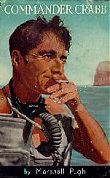
.
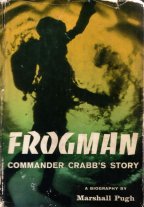 |
COMMANDER CRABB
by Marshall Pugh.
First edition August 1956. Reprinted 1956.
Macmillan and Company Limited.
Printed in great Britain.
Hardcover, dust jacket, 166 pages, mono prints. Cover
shown is th Macmillan, London, edition. [ps]
He disappeared on 19 April 1956 - ‘presumed drowned'
- under bizarre and controversial circumstances whilst diving in Portsmouth
harbour.
FROGMAN - COMMANDER CRABB'S STORY.
Published by Charles Scribner's Sons, New York. No date.
Library of Cingress 56-11868, so therefore publ;ished in 1956.
Green hard back covers with dustjacket; 208 printed pages.
Dimensions: 21.5 cms tall by 14.5 cms wide
This is the US version of the book called “Commander
Crabb”, published in the same year in the UK. The book covers Crabb’s
life from World War 2 in Gibraltar and the Mediterranean to other times
like the Submarine Truculent disaster in the Thames to his hand in the
search for the treasure on the Spanish Galleon in Tobermory Harbour in
Scotland in the 1950’s. It inevitably concludes with Crabb’s mysterious
disappearance on April 19th 1956 in Portsmouth Harbour. It
is divided into 14 chapters: “Bold Bit of Rock”, “The Green Mine”, “Dive
in the Dark”, “Underwater Working Party”, “Operation Tadpole”, “The Hour
of Trial”, “Signal From Lulu”, “Enter Belloni”, “Prisoner and Gentleman”,
“Sant’ Andrea”, “When This War is Over”, “The Truculent”, “Re-Enter Knowles”
and “Last Dice”. It is illustrated with 12 monochrome photographs of Crabb
from the war, Truculent, Tobermory and others taken while doing experimental
work with the Royal Navy.
|
 |
COMMANDER CRABB IS ALIVE
B.J. Hutton.
Tandem Publishing, London, 1968. |
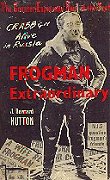
.
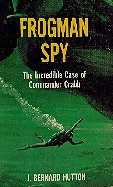 |
FROGMAN
EXTRAORDINARY.
J. Bernard Hutton.
First published in 1960 by Neville Spearman Limited,
London.
Hardcover, dustjacket, 180 pages, mono plates in separate
sections.
'The Counter Espionage Book of the Year. Crabb Alive
in Russia'. States rather provocatively that "Crabb was not drowned",
and was captured by the Russians in April 1956, take aboard the Ordzhonikidze,
flown by helicopter to Stetin, then plane to Moscow, whilst heavily drugged.
[ps][cd]
FROGMAN SPY
The Incedible Case of Commander Crabb.
J. Bernard Hutton.
First published in 1960 by Neville Spearman Limited,
London, as 'Frogman Extraordinary' (above).
This US edition is published by McDowell, Obolensky,
New York, no date). It is identical in content to Frogman Extraordinary,
including identical photographs.
The loss of Commander Crabb in 19 April 1956 has sparked
much debate and bitterness between Great Britain and Russia. This account
draws much from official statements taken at he time. I cannot comment
on its value in comparison to other books on the subject, but it appears
authoritive. [ps]
Note: Mike Welham also wrote a book called Frogman Spy.
When Welham quotes Hutton in The Crabb Enigma, he memtions Hutton's Frogman
Extraordinary. |
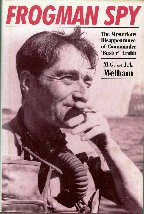 |
FROGMAN SPY
M. G. & J. A. Welham
Subtitle: The Mysterious
Dissapearance of Commander "Buster" Crabb
Published by: W. H. Allen
& Co PLC., London in 1990
Hard cover with dustjacket
- 179 printed pages
Dimensions: 24 cms tall
by 16 cms wide
Detail from dustjacket:
Commander "Buster" Crabb worked on special missions for British Naval Intelligence
and, after being transferred from the Royal Navy, undertook underwater
spying jobs for MI6. Crabb dissapered during a diving mission to
obtain information on the Russian Navy. A headless, handless body
was later identified and buried with his name on the headstone. From
that time on contraversy has continued concerning the circumastances surrounding
his "death" and the role in the "spy" network of the period. M.G.
& J.A. Welham have unearthed new evidence in their interviews with
close friends and colleagues of Crabb's - including his fiancée
, Pat Rose, and Syd Knowles, his lifelong friend and diving companion,
and even contacts of Crabb's who were in touch with him after his dissapearance
behind the Iron Curtain. The book is illustrated with 21 monochrome photographs
in the centre of the book, includinf several well known ones of him in
diving equipment. [pt] |
|
OPERATION PORTLAND
H. Houghton.
Granada Publishing, London, 1972. |
|
OPERATION SPETSNAZ
M.G. Welham and B. Quarie.
Patrick Stephens, Wellingborough, Northamptonshire, UK. 1989. |
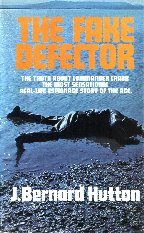 |
THE FAKE DEFECTOR
Subtitle: The Truth About Commander Crabb, The Most Sensational Real-Life
Espionage Story of the Age.
J Bernard Hutton
Published by: Howard Baker, London in 1970.
Hard back covers with dustjacket, 220 printed pages.
Dimensions: 22 cms tall by 14 cms wide
This book continues from where the author’s books from
1960 left off? It outlines Crabb’s disappearance in 1956 and the
subsequent recovery of a headless and handless corpse in Chichester harbour.
However, the author believed and documents in this book that Crabb was
not dead but was drugged, taken to Moscow and was then in the Soviet Navy
under a new name of “First Lieutenant Lev Lvovich Karoblov”? Divided
into 20 chapters; “The Fake Defector”, “Crabb Swallowed the Bait”, “Journey
to Samara”, “The Trap is Sprung”, “Missing – Presumed Dead”, “Breakfast
With Zhabotin”, “Trouble in the House”, “Point of No Return”, “A Message
for Patricia”, “Question of Identity”, “Strangers in a Train”, “Details
from Moscow”, “Sound and Fury”, “Third Officer Smith”, “Icebreakers In
Difficulties”, “The Woman From Turkey”, “Riddle of a Skull”, “Clamp-Down
at Boltenhagen”, “Naval Fabel” and “Soviet Blackmail”. Very well illustrated
with 19 monochrome photographs, including three of what was believed to
be Crabb in the Russian navy? [pt] |
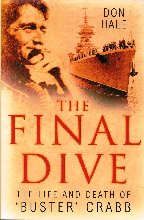 |
THE FINAL DIVE
- The Life and Death of 'Buster' Crabb
Don Hale
Published by: Sutton Publishing,
Stroud, Gloucestershire in the UK in 2007
Hard cover with dustjacket;
254 printed pages. Dimensions: 24 cms tall by 16 cms wide
Detail from dustjacket:
In April 1956, a British naval frogman, Commander Lionel 'Buster' Crabb,
disappeared during a secret mission under the hull of a Russian warship
moored in Portsmouth harbour. The ship had brought Soviet leaders
Khrushchev and Bulganin to Britain on a sensitive state visit at the height
of the cold war. After Buster Crabb failed to return, the press got
hold of the story, Anglo-Soviet relations hit an all-time low, and the
establishment closed ranks. A year later, Crabb's decapitated and
handless body was found, sparking a major row between the government, the
secret services and the Admiralty that still smoulders today. What
was Crabb doing there? How did he die? Who sanctioned the dive
that cost a man his life, claimed the jobs of the Admiralty top brass and
intelligence operatives, and contributed to the downfall of Prime Minister
Sir Anthony Eden? Who knew about the mission; who helped Crabb; who
refused, and what happened when he failed to return? The whole saga
was so sensitive that the government of that day decided to place the files
under lock and key until 2057. This is the almost unbelievable story
of what really happened to Buster Crabb - which can be fully told before
top secret files are declassified in 2057. It contains personal testimonies
from people who were involved at the time and since, much of which has
never been made public before. Don Hale reveals who masterminded
Crabb's final mission, and what were their intentions. From secret
research and inquiries by Crabb's commanding officer - exclusively available
to the author - reports by other top Royal Navy officers and officials,
private letters, confidential files, records, secret meetings and detailed
research, the author can finally reveal the truth about Crabb's extremely
colourful life and who was behind his mysterious disappearance. The book
is illustrated with 25 monochrome photographs in the centre of the book,
including several well known ones of him in diving equipment. [pt] |
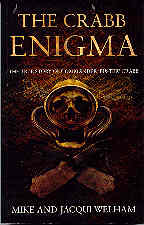 |
THE CRABB ENIGMA
The True Story of Commander ‘Buster' Crabb.
Mike and Jacqui Welham
Matador, London, UK, 2010.
Softcover, 284 pages, bibliography, mono photographs.
$28.00.
From the fly: Commander Buster Crabb, a British naval
frogman, disappeared whilst undertaking an underwater ‘spying missdion'
involving the Soviet cruiser Ordzhonikidze in 1956. Just over a year
after he disappeared, a body wasjed up headless and handless near Portsmouth.
The establishment took charge of the body and, at an inquest, declared
it to be Crabb. It's now that it was not Crabb who was buried
at Portsmouth. The problem for the establishment was that Crabb worked
for the then head of the Royal Navy, Lord Mountbatten. At the
time, US government security agents had alleged that Mountbatten was doing
‘unofficial' business with the Soviety Union. This, UK officials believe,
was a valid reason for Craabb's story to be held secret until
2056 - an unprecedented 100 years. Crabb's story also involves the British
ruling class and Royalty. It is a take of illegal activities,
art and currency smuggling, Nazi looted gold and treasure, homosexual blackmail,
threats and mysterious deaths. The authorsd and nitnesses have been subjected
to government surveillance, mail interception and telephone
tapping both by the UK authorities and Interpol. Following public publication
of the authors' previous book Forgotten Spy, attempts were made
to kill both a researcher aand a vital witness. This is the murky world
of what the establishmemt does not want you to know. [ps] |
|
|










